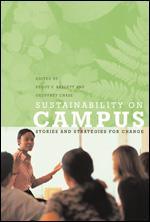 Sustainability on Campus: Stories and Strategies for Change is a series of vignettes from institutions of higher education around the US. Co-edited by Peggy Barlett, professor of anthropology at Emory University and Geoffery Chase, Dean of Undergraduate Studies (formerly) at Northern Arizona University, the compilation includes chapters from 16 schools, with one each from Barlett and Chase. Published in 2004, the book is a bit dated considering the proliferation of sustainability work currently taking place on campuses across the country (and world for that matter). However, it provides a number of insights into the trials and tribulations of initiating a sustainability program.
Sustainability on Campus: Stories and Strategies for Change is a series of vignettes from institutions of higher education around the US. Co-edited by Peggy Barlett, professor of anthropology at Emory University and Geoffery Chase, Dean of Undergraduate Studies (formerly) at Northern Arizona University, the compilation includes chapters from 16 schools, with one each from Barlett and Chase. Published in 2004, the book is a bit dated considering the proliferation of sustainability work currently taking place on campuses across the country (and world for that matter). However, it provides a number of insights into the trials and tribulations of initiating a sustainability program.
Among the more prominent individuals who authored sections for the book are David Orr, author of Earth in Mind (reviewed here), professor of environmental studies at Oberlin College. Orr, along with other essayists, details the ups and downs of bringing sustainability (most often environmental sustainability) to the attention of the wider university. Many of the lessons learned by sustainability champions are imparted through the recounting of their work in the realm of campus sustainability.
The book is divided into 5 parts:
1. Laying the Cornerstones
2. Redesigning the Curriculum
3. Building Buildings, Building Learning Communities
4. Engaging Communities, Engaging Students
5. Building System-wide Commitment
Many of the chapters were authored by anthropologists, not ecologists or environmental scientists. This includes the chapter from co-editor Peggy Barlett. The preponderance of anthropologists throughout demonstrates the intricate link between human evolution, human development, and ecological health.
Among many reoccurring themes, the notions of overcoming obstacles and building partnerships were perhaps the two most striking. In fact, building relationships may be the most important factor to ensure the success of a sustainability movement. These partnerships could materialize in any number of forms (from city regulations to faculty and staff who feel threatened by new initiatives). In addition, the importance of resilience on the level of the individual was highlighted in Allen Franz’s chapter titled “Restoring Natural Landscapes.” A number of obstacles stood in Franz’s way, but he continually pushed forward. Lastly, the human element and creating a sense of community were integral to so many of the organizers on campuses across the country.
Interestingly, some of the work has been going on for decades. At the University of California – Berkeley, their program began in the late 1960s. Ramapo College in New Jersey offers a cautionary tale of the fickle support and pendulum swings that often force sustainability onto the proverbial back burner. Johns Hopkins started the Center for a Livable Future 15 years ago “to advance thinking and action on issues of environmental sustainability, health, and equity, with particular emphasis on the links among health, diet, food production, and the environment.”
Lessons in various chapters also included the need to be intentional (i.e. clarity of thought and action); that changing behavior of occupants proved to be easier route than altering the institution or the decision making process; resilience serves people well, instead of giving in, adapting to changes (political and economic); as well as the institutionalization of sustainability so as not to be identified exclusively with one or two individuals.
Almost every chapter deals solely with environmental sustainability. Mentions of social and economic sustainability are few and far between. Although compiled several years ago, the information contained within the various stories told by faculty, staff, and in one case a former student reveal struggles and triumphs – albeit more of the former at times.
The importance of facilitation and collaboration appear throughout many of the chapters. What also stood out in the cases of Allegheny and Middlebury Colleges was the example of the university as a driving agent for local economy. Many times the “town to gown” relationships between schools and their surroundings can be contentious. However, these schools demonstrate how the university can be a positive agent for economic growth beyond the campus and town and into the greater region. For example, Emory University recently announced (since the publishing of the book) that 75% of their food served in the hospital and cafeterias will come from local or sustainable sources. As per the policy, “highest priority [will be given] to Georgia farmers, through relationships with known producers. As products become available, we hope to buy more of our food from areas close to Emory.” In order for schools to be sustainable, they must work to improve the health of the entire area.
[Image source]

